Michigan is home to many beautiful birds, and among them, black birds are some of the most striking. From the shores of the Great Lakes to the deep forests, these birds can be found in various habitats across the state. Black birds come in many shapes and sizes, each with its own unique characteristics and behaviors. Whether you’re an avid birdwatcher or just someone who enjoys nature, spotting these birds can be a delightful experience. In this article, we will explore 20 types of black birds that you might see in Michigan, providing a glimpse into their fascinating world. So, grab your binoculars and let’s discover these wonderful black-feathered friends!
List of 20 Types Of Black Birds in Michigan
| No. | Bird Name | Description |
|---|---|---|
| 1 | American Crow | Large black bird, known for its intelligence and loud cawing. |
| 2 | Common Grackle | Iridescent black feathers with a long tail and bright yellow eyes. |
| 3 | Red-winged Blackbird | Black with bright red and yellow shoulder patches, often found in wetlands. |
| 4 | European Starling | Glossy black with purple and green sheen, often seen in large flocks. |
| 5 | Brewer’s Blackbird | Glossy black feathers, slender body, often seen in fields and open areas. |
| 6 | Brown-headed Cowbird | Black body with a brown head, known for laying eggs in other birds’ nests. |
| 7 | Rusty Blackbird | Black with a hint of rusty color, often found near water in winter. |
| 8 | Eastern Kingbird | Black and white bird, known for its aggressive behavior towards larger birds. |
| 9 | Common Raven | Very large black bird, known for its deep croaking call. |
| 10 | Black-capped Chickadee | Small bird with a black cap and bib, white cheeks, and a fluffy appearance. |
| 11 | Dark-eyed Junco | Small black and white bird, often seen hopping on the ground. |
| 12 | Fish Crow | Smaller than the American Crow, with a distinctive nasal call. |
| 13 | Bobolink | Black with white back and yellow cap, known for its bubbly song. |
| 14 | White-winged Crossbill | Black bird with distinctive white wing bars and crossed bill. |
| 15 | Purple Martin | Large swallow with iridescent blackish-blue feathers, often seen in colonies. |
| 16 | Tree Swallow | Iridescent blue-black above and white below, often seen around water. |
| 17 | Chimney Swift | Sooty black bird with a cigar-shaped body, often seen flying in groups. |
| 18 | Black-throated Blue Warbler | Small bird with black throat and blue back, found in forests. |
| 19 | Black-and-white Warbler | Small bird with distinctive black and white stripes, often seen climbing tree trunks. |
| 20 | Yellow-headed Blackbird | Black body with a bright yellow head, often found in marshes. |
20 Types of Black Birds in Michigan: Details
Michigan is a great place for birdwatchers, home to many types of blackbirds that are known for their beautiful colors and interesting behaviors. These birds can be found in different environments throughout the state, from forests to wetlands. In this guide, we look at 20 kinds of blackbirds found in Michigan, sharing details about their looks, diet, and where they live. Some common blackbirds in Michigan include the Red-winged Blackbird, Common Grackle, and Brown-headed Cowbird. These birds help the environment by controlling insect populations and spreading seeds. Whether you are a seasoned birdwatcher or just starting, this guide will help you appreciate these amazing birds and their important roles in nature.
1. American Crow
The American Crow is a smart, adaptable bird found across North America, known for its all-black feathers and large wingspan of 17-21 inches. It thrives in various places like forests, farmlands, cities, and coastlines. As an omnivore, it eats seeds, insects, small animals, and carrion, which helps it live close to humans. American Crows are social and communicate with different calls. In winter, they often gather in huge flocks. Known for their intelligence, they use tools, recognize human faces, and solve complex problems, making them one of the most fascinating birds around.
| Attribute | Description |
|---|---|
| Scientific Name | Corvus brachyrhynchos |
| Average Lifespan | 7-8 years (up to 14 years in the wild) |
| Diet | Omnivorous (fruits, seeds, insects, small animals, carrion, human food waste) |
| Location | Statewide, in forests, fields, urban areas |
| Description | Large black bird known for its intelligence, social behavior, and loud cawing. |
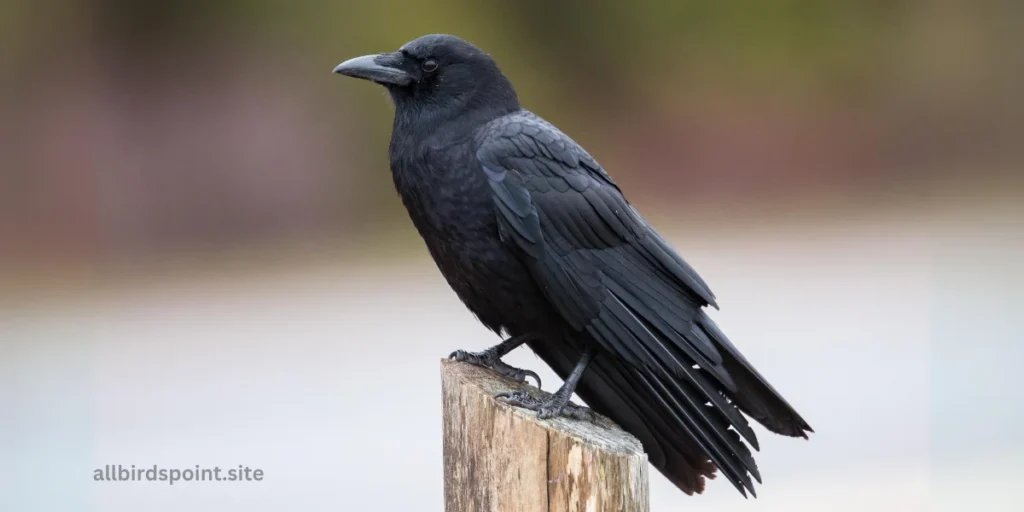
2. Common Grackle
The Common Grackle is a striking and adaptable bird found throughout North America, easily recognized by its glossy black feathers that often shine with purple, green, and blue hues in sunlight. Slightly longer than a crow, the grackle has a long tail, slender body, and bright yellow eyes. It thrives in varied habitats, including woodlands, marshes, and urban areas, and eats a wide range of foods like insects, seeds, and even small animals. Known for its loud, harsh calls and large gatherings in winter, the grackle is highly social. These birds are clever and resourceful, often seen working together to find food, making them an interesting and resilient species.
| Attribute | Description |
|---|---|
| Scientific Name | Quiscalus quiscula |
| Average Lifespan | 17 years in the wild |
| Diet | Omnivorous (insects, small fish, fruits, seeds, garbage) |
| Location | Open fields, marshes, urban areas |
| Description | Iridescent black feathers with a long tail and bright yellow eyes. |

3. Red-winged Blackbird
The Red-winged Blackbird is a striking bird found widely across North America, easily recognized by the bright red and yellow patches on the shoulders of the male’s black feathers. Females are streaky brown and blend well with marshy habitats where these birds are often found. Red-winged Blackbirds thrive in wetlands, fields, and even roadside ditches, feeding on insects and seeds. They are known for their distinct, musical calls and territorial behavior, especially during breeding season when males aggressively defend their nesting areas. Social and adaptable, they often form large flocks in the winter, making them a familiar and iconic sight in North American landscapes.
| Attribute | Description |
|---|---|
| Scientific Name | Agelaius phoeniceus |
| Average Lifespan | 2 years on average (up to 15 years) |
| Diet | Omnivorous (insects, seeds, grains) |
| Location | Wetlands, marshes, meadows |
| Description | Black with bright red and yellow shoulder patches, often found in wetlands. |

4. European Starling
The European Starling is a small, stocky bird with iridescent black feathers that shimmer with purple and green, especially in sunlight. Originally brought to North America in the 1800s, starlings are now widespread across the continent, thriving in cities, farmlands, and open woodlands. They are highly adaptable and feed on insects, fruits, and seeds, often foraging in large, noisy flocks. Known for their ability to mimic sounds and their complex, whistling songs, starlings can imitate other birds, animals, and even machinery. During winter, they form large, synchronized flocks called murmurations, creating spectacular patterns in the sky. Social, vocal, and resourceful, the European Starling is one of the most abundant and recognizable birds in North America.
| Attribute | Description |
|---|---|
| Scientific Name | Sturnus vulgaris |
| Average Lifespan | 2-3 years (up to 15 years) |
| Diet | Omnivorous (insects, fruits, seeds, nectar) |
| Location | Urban areas, farmlands, open woodlands |
| Description | Glossy black with a purple and green sheen, often seen in large flocks. |
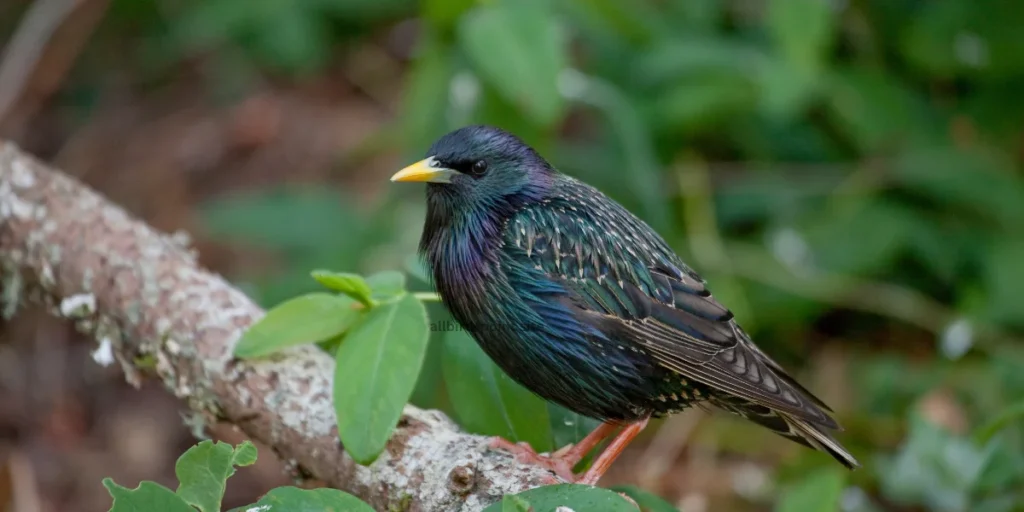
5. Brewer’s Blackbird
The Brewer’s Blackbird is a medium-sized, social bird found across western and central North America, especially in open fields, parks, and near water sources. Males are glossy black with striking purple and green highlights, while females are a more subdued gray-brown. These birds are adaptable and eat a wide variety of foods, including insects, seeds, and grains. Known for their calm, curious nature, Brewer’s Blackbirds are often seen foraging in open areas or gathering in small flocks. Their calls are simple and sharp, and during breeding season, males display a characteristic pose with wings slightly spread and tail fanned. Commonly seen in both urban and rural settings, they are a familiar sight in many parts of their range.
| Attribute | Description |
|---|---|
| Scientific Name | Euphagus cyanocephalus |
| Average Lifespan | 12 years |
| Diet | Omnivorous (insects, seeds, grains) |
| Location | Fields, meadows, near water bodies |
| Description | Glossy black feathers, slender body, often seen in fields and open areas. |

6. Brown-headed Cowbird
The Brown-headed Cowbird is a small, stocky blackbird found across much of North America. Males are easily recognized by their glossy black bodies and rich brown heads, while females are a plain grayish-brown. Unlike most birds, cowbirds are brood parasites, meaning they lay their eggs in the nests of other birds, leaving them to raise their young. This behavior has allowed them to thrive in various habitats, from grasslands to forest edges and suburban areas. Brown-headed Cowbirds primarily feed on seeds and insects, often foraging on the ground or in open fields. Their distinctive, bubbly song and unique breeding behavior make them a fascinating and sometimes controversial part of North American birdlife.
| Attribute | Description |
|---|---|
| Scientific Name | Molothrus ater |
| Average Lifespan | 16 years |
| Diet | Omnivorous (seeds, insects) |
| Location | Grasslands, farmlands, forest edges |
| Description | Black body with a brown head, known for laying eggs in other birds’ nests. |
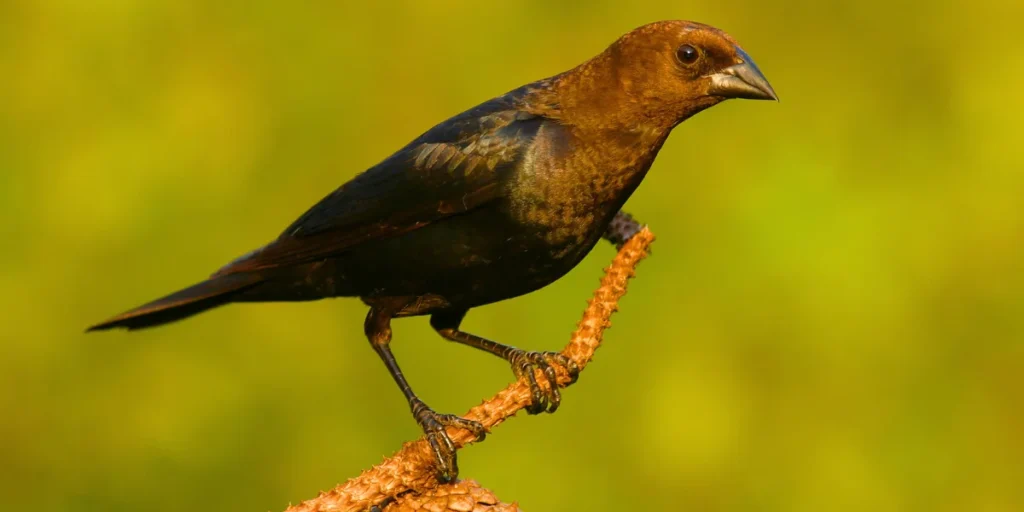
7. Rusty Blackbird
The Rusty Blackbird is a medium-sized bird found primarily in wetland areas across North America, particularly during migration and in winter. Males are characterized by their iridescent black plumage with rusty brown edges, which give them a distinctive appearance, while females are generally brown with streaked underparts. They are often found in small flocks, foraging on the ground for seeds, insects, and other invertebrates. Rusty Blackbirds are known for their soft, musical calls and are typically seen in shrubby wetlands, marshes, and forest edges. Their populations have declined in recent years, making them a species of concern, and they are most commonly spotted during their migration periods in spring and fall.
| Attribute | Description |
|---|---|
| Scientific Name | Euphagus carolinus |
| Average Lifespan | 8 years |
| Diet | Insectivorous (insects, crustaceans, small fish) |
| Location | Wetlands, swamps, forests (in winter) |
| Description | Black with a hint of rusty color, often found near water in winter. |

8. Eastern Kingbird
The Eastern Kingbird is a medium-sized songbird found throughout North America, particularly in open fields, meadows, and along the edges of forests. Recognizable by its striking black and white plumage, the male has a dark gray to black head and back, contrasting with its white underparts and a distinctive white tip on its tail. This bird is known for its aggressive behavior, often defending its territory against other birds, including much larger species. Eastern Kingbirds primarily feed on insects, catching them in mid-air or picking them off plants. Their sharp, buzzing calls and acrobatic flight make them a lively presence in their habitat. During migration, they can often be seen perched on fences or wires, surveying their surroundings.
| Attribute | Description |
|---|---|
| Scientific Name | Tyrannus tyrannus |
| Average Lifespan | 10 years |
| Diet | Insectivorous (insects, berries) |
| Location | Open fields, farmlands, along waterways |
| Description | Black and white bird, known for its aggressive behavior towards larger birds. |
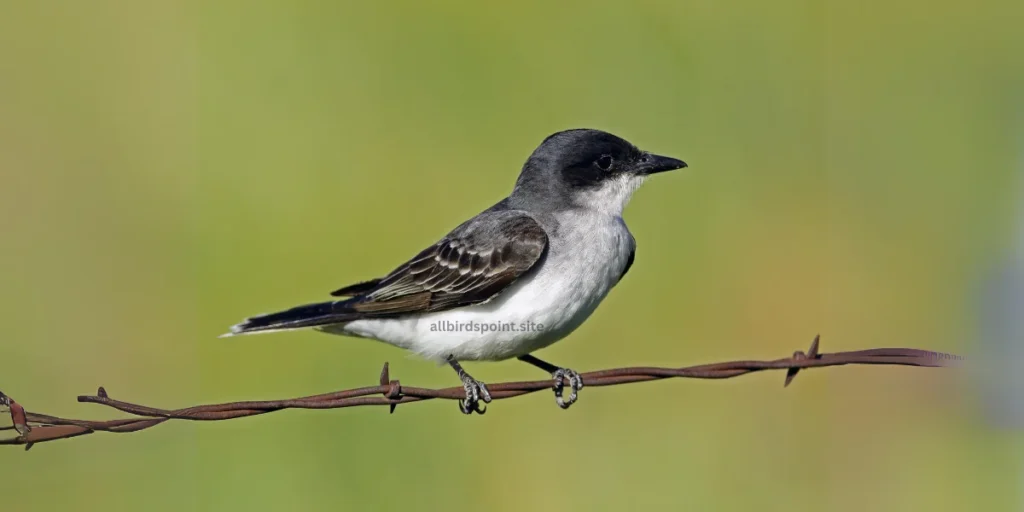
9. Common Raven
The Common Raven is a large, intelligent bird found across the Northern Hemisphere, known for its all-black plumage and distinctive wedge-shaped tail. Measuring about 24 inches long, it is larger than its cousin, the American Crow, and features a thick, strong bill and shaggy throat feathers. Ravens are highly adaptable and can thrive in a variety of habitats, from forests and mountains to deserts and urban areas.
They are omnivorous, feeding on a diverse diet that includes insects, small mammals, carrion, and human food scraps. Known for their problem-solving abilities, vocalizations, and playful behavior, Common Ravens can mimic sounds and have complex social interactions. Their deep, resonant calls and impressive flying skills, including acrobatic displays, make them a fascinating species to observe in the wild.
| Attribute | Description |
|---|---|
| Scientific Name | Corvus corax |
| Average Lifespan | 10-15 years (up to 40 years in captivity) |
| Diet | Omnivorous (insects, small animals, fruits, seeds, carrion) |
| Location | Forests, mountains, coastal areas |
| Description | Very large black bird, known for its deep croaking call. |

10. Black-capped Chickadee
The Black-capped Chickadee is a small, friendly songbird commonly found in North America, particularly in forests, woodlands, and backyard feeders. Recognizable by its distinctive black cap and bib, white cheeks, and soft gray-brown body, this bird is about 4.5 to 5.5 inches long. Known for its cheerful, whistled call of “chick-a-dee-dee-dee,” the Black-capped Chickadee is very social and often forages in small flocks, flitting about in search of seeds, insects, and berries.
These birds are known for their curious and bold nature, often approaching humans closely, especially at feeders. They also exhibit remarkable intelligence, capable of remembering the locations of food caches. In winter, they are able to lower their body temperature at night to conserve energy, showcasing their adaptability to harsh conditions.
| Attribute | Description |
|---|---|
| Scientific Name | Poecile atricapillus |
| Average Lifespan | 2-3 years (up to 12 years) |
| Diet | Omnivorous (insects, seeds, berries) |
| Location | Deciduous and mixed forests, suburban areas |
| Description | Small bird with a black cap and bib, white cheeks, and a fluffy appearance. |

11. Dark-eyed Junco
The Dark-eyed Junco is a small, sparrow-like bird commonly found across North America, particularly in forests, gardens, and shrubby areas. Measuring about 6 to 7 inches in length, it is easily recognized by its dark gray or brown plumage, with a distinct white belly and outer tail feathers. There are several subspecies of Dark-eyed Juncos, with the most common being the slate-colored form, which has a dark slate-gray back and white underparts.
These birds are often seen foraging on the ground for seeds, grains, and insects, especially in winter when they gather in flocks. Known for their sweet, trilling songs, Dark-eyed Juncos are a familiar sight at feeders and during backyard birdwatching. They are adaptable to a variety of habitats and are especially prevalent in North America during the colder months, migrating south from their breeding grounds in Canada and the northern United States.
| Attribute | Description |
|---|---|
| Scientific Name | Junco hyemalis |
| Average Lifespan | 3-11 years |
| Diet | Omnivorous (seeds, insects) |
| Location | Forests, woodland edges, gardens |
| Description | Small black and white bird, often seen hopping on the ground. |

12. Fish Crow
The Fish Crow is a medium-sized bird found primarily along the eastern coast of the United States, particularly in coastal areas and near freshwater bodies. Similar in appearance to the American Crow, it has a glossy black plumage but is slightly smaller and has a more slender bill. Fish Crows are known for their distinctive, nasal calls, which sound like “ah-ah” or “caw-caw,” differentiating them from their more common relatives.
They primarily feed on a diet of fish, crustaceans, and other aquatic organisms, often foraging along shorelines, in marshes, or scavenging near fishing activities. Fish Crows are social birds, often seen in pairs or small groups, and are known to be quite intelligent, displaying problem-solving skills and complex social behaviors. They are most commonly observed in the spring and summer during the breeding season, where they build their nests in trees or shrubs near water sources.
| Attribute | Description |
|---|---|
| Scientific Name | Corvus ossifragus |
| Average Lifespan | 14 years |
| Diet | Omnivorous (fish, crustaceans, insects, fruits) |
| Location | Coastal areas, wetlands, riverbanks |
| Description | Smaller than the American Crow, with a distinctive nasal call. |
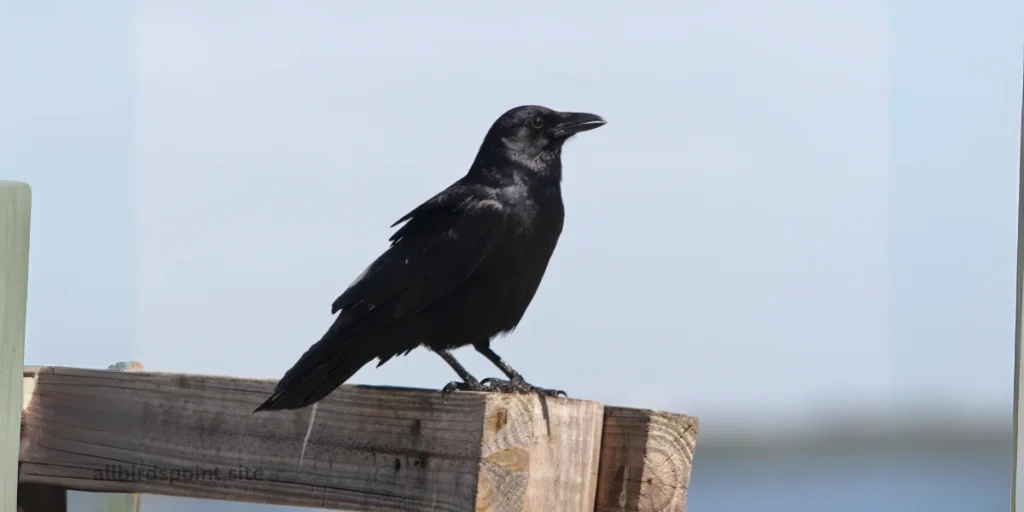
13. Bobolink
The Bobolink is a small, migratory songbird found primarily in North America, particularly in grasslands and open fields during the breeding season. Males are easily recognized by their striking plumage, featuring a black body, white back, and buff-colored nape, while females are more subtly colored in brown and streaked patterns. Measuring about 5.5 to 6.5 inches in length, Bobolinks are known for their distinctive, bubbly song, which is often described as a series of cheerful notes.
They primarily feed on seeds, insects, and grasses, foraging on the ground and in low vegetation. Bobolinks are unique among songbirds for their migratory behavior, traveling long distances to winter in South America. They typically nest on the ground in tall grass, making them vulnerable to habitat loss, which has led to declines in some populations. Their charming songs and striking appearance make them a delightful sight in their grassland habitats during the summer months.
| Attribute | Description |
|---|---|
| Scientific Name | Dolichonyx oryzivorus |
| Average Lifespan | 5-9 years |
| Diet | Insectivorous (insects, seeds, grains) |
| Location | Grasslands, meadows |
| Description | Black with white back and yellow cap |

14. White-winged Crossbill
The White-winged Crossbill is a distinctive finch found primarily in coniferous forests across Canada and parts of the northern United States. Known for its unique, crossed bills—where the tips of the upper and lower mandibles overlap—this adaptation allows them to easily extract seeds from conifer cones. Males are typically bright red with black wings and a black tail, while females are more muted in color, often appearing yellowish or brown with similar wing patterns.
Measuring about 6 to 7 inches in length, these birds are highly social and often found in flocks, especially during the breeding season. White-winged Crossbills primarily feed on the seeds of spruce, pine, and fir trees, and their diets can vary based on cone availability. Their cheerful, chirping calls and playful behavior make them a lively presence in their forest habitats, and they are known to breed irregularly based on food availability, often nesting in the winter months when cones are plentiful.
| Attribute | Description |
|---|---|
| Scientific Name | Loxia leucoptera |
| Average Lifespan | 4-8 years |
| Diet | Granivorous (conifer seeds, insects) |
| Location | Coniferous forests |
| Description | Black bird with distinctive white wing bars and crossed bill. |
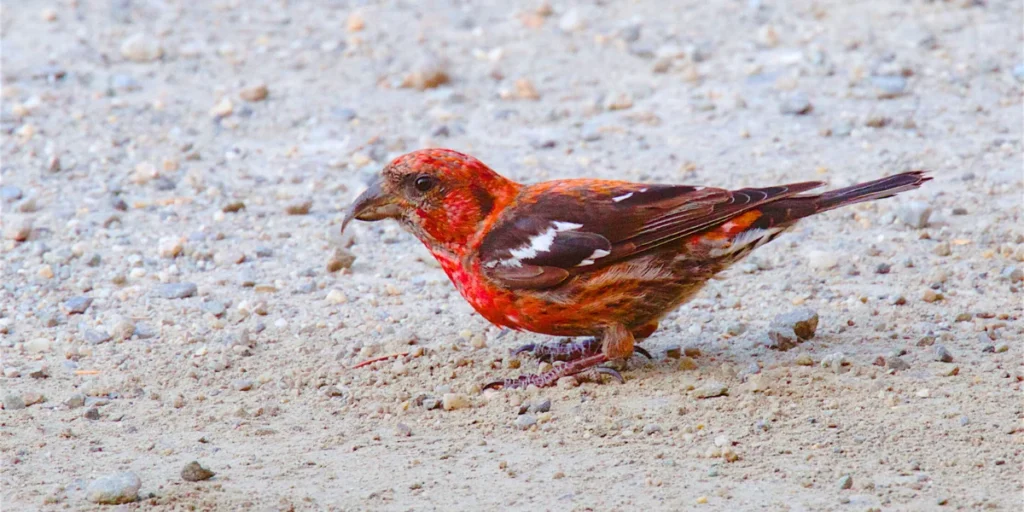
15. Purple Martin
The Purple Martin is a large swallow species found across North America, particularly known for its aerial acrobatics and social behavior. Males are striking with their glossy, iridescent dark blue to purple plumage, while females are more subdued, sporting a mix of brown and gray with lighter underparts. Measuring about 7.5 to 8.5 inches in length, Purple Martins are often seen soaring gracefully in search of flying insects, which make up a significant portion of their diet.
These birds are highly social and typically nest in colonies, often preferring man-made structures like birdhouses, which have become popular among bird enthusiasts. Their cheerful, bubbly calls can often be heard around their nesting sites. Purple Martins are migratory, wintering in South America, and are one of the first bird species to return to North America in the spring, signaling the arrival of warmer weather. Their presence is a welcome sight in many communities, where they are cherished for their beauty and beneficial role in controlling insect populations.
| Attribute | Description |
|---|---|
| Scientific Name | Progne subis |
| Average Lifespan | 5-7 years |
| Diet | Insectivorous (flying insects) |
| Location | Near water bodies, open areas, often seen in colonies |
| Description | Large swallow with iridescent blackish-blue feathers. |
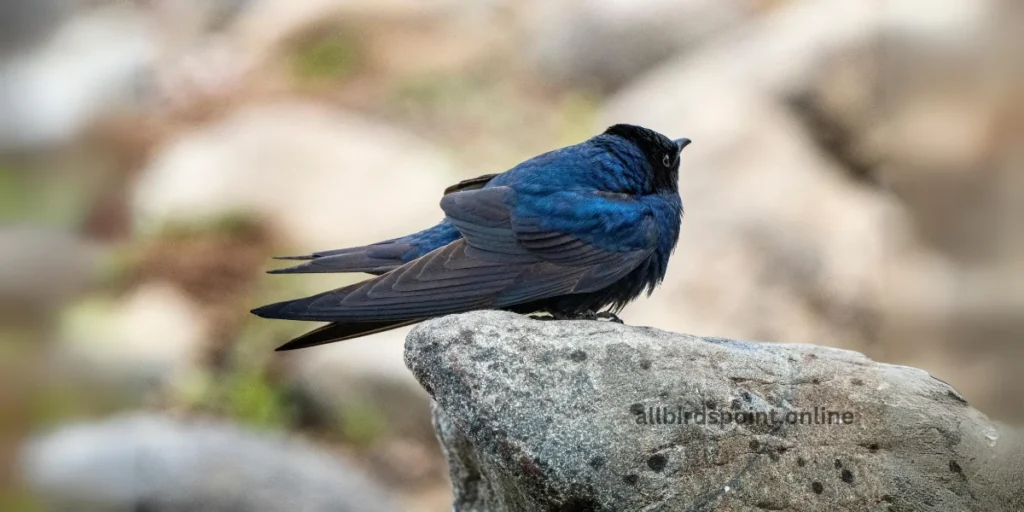
16. Tree Swallow
The Tree Swallow is a small, agile bird found throughout North America, particularly near water bodies, open fields, and in urban areas. Recognizable by its striking iridescent blue-green upperparts and white underparts, it measures about 5.5 to 6.5 inches in length. Tree Swallows are known for their graceful flight and acrobatic maneuvers as they catch flying insects mid-air, which make up a large part of their diet. They are social birds, often seen in small flocks, especially during migration and at feeding sites.
During the breeding season, Tree Swallows prefer to nest in tree cavities, old woodpecker holes, or man-made nest boxes. Their cheerful, melodic calls can often be heard in their habitats. These swallows are migratory, wintering in Central America and the southern United States, and are among the first birds to return in the spring, bringing a lively presence to the landscape.
| Attribute | Description |
|---|---|
| Scientific Name | Tachycineta bicolor |
| Average Lifespan | 2.7 years (up to 12 years) |
| Diet | Insectivorous (flying insects) |
| Location | Near water, open fields |
| Description | Iridescent blue-black above and white below, often seen around water. |

17. Chimney Swift
The Chimney Swift is a small, aerial bird found throughout North America, particularly in urban areas where it often nests in chimneys and other vertical structures. Measuring about 4.5 to 5.5 inches in length, it has a distinctive, cigar-shaped body with long, pointed wings and a short, square tail. The Chimney Swift is known for its rapid, agile flight, often seen swooping and darting through the air in search of insects, which make up the majority of its diet.
These birds are highly social and often gather in large flocks, particularly during migration when they roost together in significant numbers. Their soft, twittering calls can be heard as they fly. Chimney Swifts are migratory, spending their winters in Central and South America, and they are unique among birds in their nesting habits, as they build their nests using twigs and glue them to vertical surfaces, creating a cup-like structure. Their presence is a delightful part of summer evenings in many neighborhoods, where they contribute to the vibrant urban wildlife.
| Attribute | Description |
|---|---|
| Scientific Name | Chaetura pelagica |
| Average Lifespan | 4.6 years (up to 14 years) |
| Diet | Insectivorous (flying insects) |
| Location | Urban areas, near chimneys, open skies |
| Description | Sooty black bird with a cigar-shaped body, often seen flying in groups. |

18. Black-throated Blue Warbler
The Black-throated Blue Warbler is a small, colorful songbird primarily found in the eastern forests of North America. Males are striking, with bright blue upperparts, a black throat, and yellow underparts, while females are more subdued in color, featuring olive-brown upperparts and a lighter yellowish belly. Measuring about 4.5 to 5.5 inches in length, this warbler is often found in dense, shrubby habitats, particularly in areas with thick understory growth.
Black-throated Blue Warblers are known for their beautiful, melodic songs, which they use to establish territory during the breeding season. Their diet mainly consists of insects and other small invertebrates, which they forage for among the foliage. These birds are migratory, wintering in the Caribbean and parts of Central America, and they are often seen during spring and fall migrations as they travel between their breeding and wintering grounds. Their vibrant colors and delightful songs make them a favorite among birdwatchers and nature enthusiasts.
| Attribute | Description |
|---|---|
| Scientific Name | Setophaga caerulescens |
| Average Lifespan | 2-4 years |
| Diet | Insectivorous (insects, spiders) |
| Location | Deciduous and mixed forests |
| Description | Small bird with black throat and blue back, found in forests. |
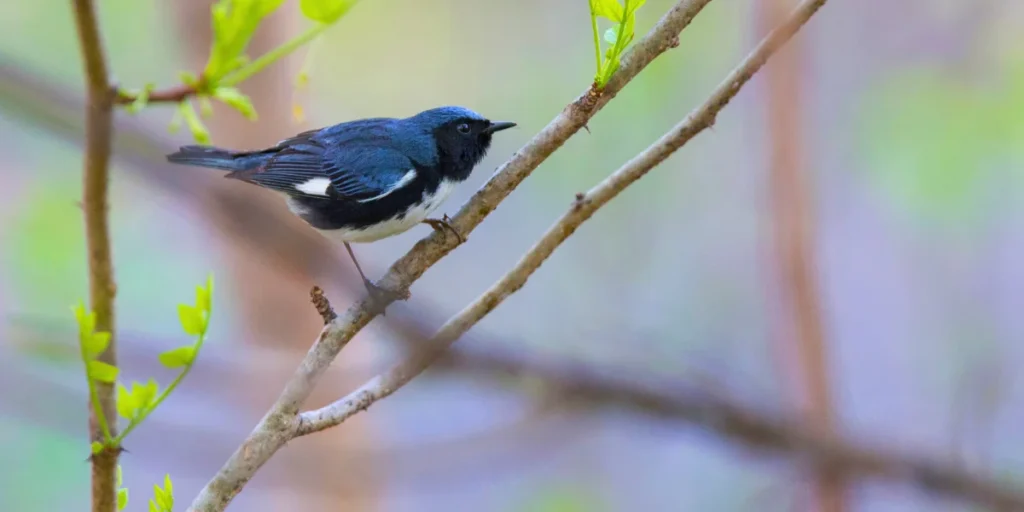
19. Black-and-white Warbler
The Black-and-white Warbler is a small, striking songbird found throughout North America, particularly in wooded areas and forests. Easily recognized by its bold black and white stripes, this warbler has a slender body, a long tail, and measures about 4.5 to 5.5 inches in length. Unlike many other warblers, the Black-and-white Warbler often forages along tree trunks and branches, using its strong legs to climb and search for insects and larvae hidden in the bark.
Its distinctive, melodious song consists of a series of clear notes, often described as “swee-swee-swee.” This species is migratory, wintering in Central America and the Caribbean, and can be observed during migration in spring and fall as it travels between its breeding and wintering grounds. The Black-and-white Warbler’s unique foraging behavior and striking appearance make it a fascinating bird to observe in its natural habitat.
| Attribute | Description |
|---|---|
| Scientific Name | Mniotilta varia |
| Average Lifespan | 4-5 years |
| Diet | Insectivorous (insects, spiders) |
| Location | Deciduous forests, woodland edges |
| Description | Small bird with distinctive black and white stripes, often seen climbing tree trunks. |

20. Yellow-headed Blackbird
The Yellow-headed Blackbird is a striking bird found primarily in wetland habitats across North America, particularly in the western and central regions. Males are easily recognized by their vivid yellow head and chest, contrasting with their black body and wings, while females are more subdued, featuring a brownish plumage with streaked underparts. Measuring about 8 to 9 inches in length, these birds are often seen foraging in marshes and along the edges of ponds, feeding on seeds, insects, and aquatic vegetation.
Known for their loud, distinctive calls, Yellow-headed Blackbirds are highly social and often form large flocks, especially during the breeding season. They typically nest in dense reeds or cattails, where they create cup-shaped nests. Their striking appearance and bold behavior make them a fascinating sight for birdwatchers and nature enthusiasts in their natural habitats.
| Attribute | Description |
|---|---|
| Scientific Name | Xanthocephalus xanthocephalus |
| Average Lifespan | 11 years |
| Diet | Omnivorous (insects, seeds, grains) |
| Location | Marshes, wetlands, open fields |
| Description | Black body with a bright yellow head, often found in marshes. |
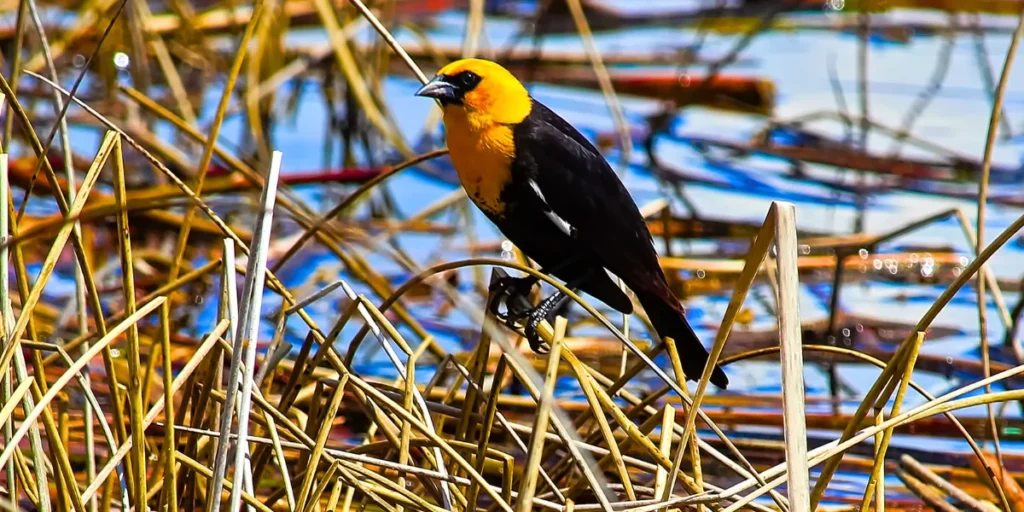
How to attract Black Birds in Michigan
ttracting blackbirds, including species like the Red-winged Blackbird and Common Grackle, in Michigan can be an enjoyable activity. Here are some effective strategies to attract these birds to your yard or garden:
- Provide Food Sources: Blackbirds are omnivorous and enjoy a variety of foods. Offer sunflower seeds, corn, milo, and mealworms in feeders or on the ground. They are particularly attracted to suet feeders during the colder months.
- Create a Suitable Habitat: Blackbirds prefer open areas with nearby cover, such as shrubs or trees. Plant native vegetation like grasses, wildflowers, and shrubs to create a natural habitat that offers shelter and nesting sites.
- Install Water Features: A birdbath or shallow pond can attract blackbirds, especially during hot summer months. Make sure to change the water regularly and keep the area clean.
- Set Up Nesting Boxes: While blackbirds generally nest in dense vegetation, providing nesting materials like dried grasses or twigs can encourage them to build nests nearby.
- Limit Disturbances: Blackbirds are more likely to visit areas that are quiet and undisturbed. Minimize noise and activity in your yard, especially during their breeding season.
- Mimic Their Natural Environment: If you have a pond or wetland area, consider adding cattails or other marsh plants. This can create an inviting habitat for species like the Red-winged Blackbird.
- Provide Open Feeding Areas: Blackbirds often forage in open fields, so creating a feeding area with scattered seeds or grains on the ground can attract them.
By implementing these strategies, you can create an inviting environment for blackbirds and enjoy their presence in your Michigan yard.
Why Are Black Birds Important in Michigan?
Pest Control
Many black birds help control insect populations. Birds like the Red-winged Blackbird eat insects that could harm crops and plants. By eating pests, these birds keep gardens and farms healthy.
Seed Dispersal
Some black birds, like the American Crow, help spread seeds by eating fruits and then moving to different areas. This helps new plants grow, and keeps forests and fields full of plants.
Ecosystem Balance
Black birds play a big role in keeping ecosystems healthy. They are part of the food chain, feeding on insects and small animals, and also being food for larger predators.
Conservation Efforts for Black Birds in Michigan
Protecting Wetlands
Wetlands are very important for black birds, especially those like the Rusty Blackbird and Yellow-headed Blackbird, which depend on marshy areas for food and nesting. Many groups in Michigan are working to protect these areas from pollution and development.
- Wetland Restoration Projects: There are programs aimed at cleaning up and restoring wetlands to make sure birds have safe places to live.

How People Can Help
If you want to help black birds in Michigan, there are a few things you can do:
- Plant Native Plants: Plants that grow naturally in Michigan provide food and shelter for birds.
- Put Up Bird Feeders: If you live in Michigan, putting up a bird feeder with seeds will attract many types of birds, including black birds.
- Report Bird Sightings: If you see any interesting birds, you can report them to local birdwatching groups or websites like eBird.
Interesting Facts About Black Birds in Michigan
- Birdwatching Hotspots: Michigan has many great places to see black birds, including places like the Detroit River International Wildlife Refuge and Muskegon State Park.
- Migratory Birds: Some black birds migrate from Michigan to warmer places during the winter. Others, like the Red-winged Blackbird, stay in Michigan all year.
- Birdsong: Blackbirds are known for their songs. The Red-winged Blackbird has a distinctive “conk-a-ree!” call, while the Common Grackle’s call sounds harsh and loud.
How to Spot Black Birds in Michigan
Size and Shape
One way to tell black birds apart is by their size and shape. For example, the Common Grackle is bigger than the European Starling, and the Fish Crow is smaller than the American Crow.
Color and Shine
Many black birds have shiny feathers. The Common Grackle has feathers that can shine purple or green in the sunlight, while the Red-winged Blackbird has bright red and yellow patches on its wings.
Sound
Birds also make different sounds. The Red-winged Blackbird has a clear “conk-a-ree!” song, while the European Starling makes a variety of chattering noises. You can listen for these sounds to help identify the birds.
Tips for Watching Black Birds in Michigan
Watching black birds in Michigan can be an enjoyable and rewarding activity. Here are five simple tips to help you spot and appreciate these fascinating birds:
Know Where to Look
- Black birds are often found in wetlands, marshes, and open fields. Check places like Harrisville State Park and Detroit River International Wildlife Refuge. You may also spot them in wooded areas or feeding in large groups along roadsides.
Best Times to Watch
- The best times to see black birds are early morning and late afternoon, when they are most active. Spring and summer are also prime seasons for birdwatching, as many black birds are in their breeding plumage and actively singing.
Use Binoculars
- Binoculars help you get a better view from a distance without disturbing the birds. They are especially useful when trying to identify different species.
Learn the Calls
- Black birds like Red-winged Blackbirds and Crows have distinctive calls. Listening for these calls will help you spot the birds even if you can’t see them. Apps and bird guides can help you learn the sounds.
Be Patient and Respectful
- Birdwatching requires patience. Stay quiet and still, giving the birds time to appear. Keep your distance to avoid disturbing their natural behavior, and use a camera with a zoom lens for photos.
By following these tips, you’ll have a better chance of spotting and enjoying Michigan’s diverse black bird species!
Can We Click Pictures of Black Birds in Michigan?
Yes, you can take pictures of black birds in Michigan. Here are some simple tips for capturing great photos:
Use a Zoom Lens
- A zoom lens (200mm or more) helps you take close-up shots without getting too close to the birds.
Respect Their Space
- Stay at a safe distance to avoid disturbing the birds. Use your zoom instead of moving closer.
Capture Action Shots
- Look for birds in action, like flying or feeding, to make your photos more interesting.
Use Natural Light
- Take photos during early morning or late afternoon for the best lighting. Avoid using flash.
Be Patient
- Birds may take time to appear, so be patient and have your camera ready when they do.
By following these tips, you’ll be able to take beautiful photos of Michigan’s black birds!
Can We Hunt Black Birds in Michigan?
In Michigan, hunting laws are clear about which birds can and cannot be hunted. Black birds in Michigan can be divided into two main groups: migratory game birds and non-game birds. Here’s a simple breakdown of the hunting rules:
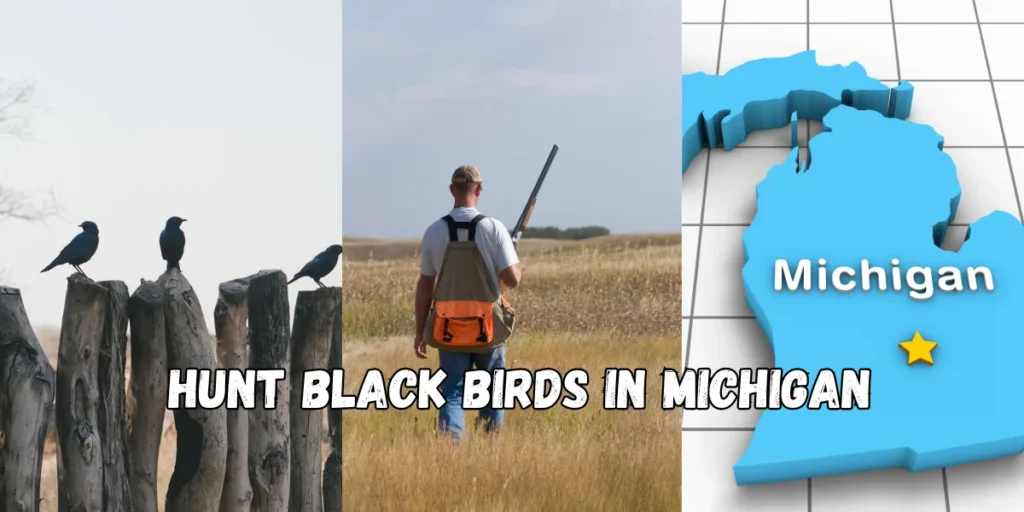
Migratory Game Birds
Some black birds, like crows, can be hunted, but there are certain rules and seasons to follow:
- Crows: Crows can legally be hunted in Michigan, but there are specific times when this is allowed. The hunting season for crows usually runs from mid-March to late November. Hunters need to follow the rules about how many crows can be hunted each day, the times they can hunt, and the permits they need. It’s important to always check the hunting regulations for the current year, as rules can change.
- Waterfowl (like ducks and geese, which can sometimes appear dark or black): Waterfowl, although not strictly black birds, are also hunted during certain seasons. Hunters must follow strict rules for these birds, including needing a federal migratory bird stamp and a state waterfowl hunting license.
Non-Game Birds
Most other black birds, like Red-winged Blackbirds, European Starlings, and Common Grackles, are not allowed to be hunted because they are protected by federal law under the Migratory Bird Treaty Act. This means it is illegal to hunt or trap these birds in Michigan and across the United States. These birds are important to the environment, helping with things like spreading seeds and controlling insects, which is why they are protected.
- European Starlings and House Sparrows: Even though these birds are not protected under the Migratory Bird Treaty Act, they are still considered pests in many areas. In some cases, people are allowed to control their numbers, but hunting or trapping them must still follow local laws.
Key Things to Remember:
- Always check the current regulations in Michigan before going hunting.
- If you plan to hunt crows or waterfowl, make sure to follow the seasons, bag limits, and licensing requirements.
- It is illegal to hunt protected birds like Red-winged Blackbirds and Common Grackles.
- Michigan’s Department of Natural Resources (DNR) provides the latest rules on bird hunting, so it’s important to consult their website or other official sources.
In short: While you can hunt crows under certain conditions, many black birds like Red-winged Blackbirds and Common Grackles are protected and cannot be hunted. Always be sure you know the laws before hunting any bird species.
FAQs
Q1: When is the best time to see black birds in Michigan?
A: The best times are in the spring and fall, when many black birds migrate through Michigan.
Q2: Do black birds hurt crops?
A: Some black birds, like the Common Grackle, might eat some crops, but many help by eating pests that damage plants.
Q3: How can I attract black birds to my garden?
A: You can attract black birds by setting up bird feeders, providing water, and planting native plants.
Q4: What should I do if I find an injured black bird?
A: If you find an injured bird, it’s best to contact a local wildlife rescue group or animal hospital.
Conclusion
Black birds are an important part of Michigan’s wildlife. From the bold Red-winged Blackbird to the shy Rusty Blackbird, these birds help control pests, spread seeds, and keep nature in balance. By protecting their habitats and watching them in the wild, we can make sure that black birds continue to thrive in Michigan for years to come. Whether you’re a birdwatcher or just curious, these amazing creatures deserve our attention and care.
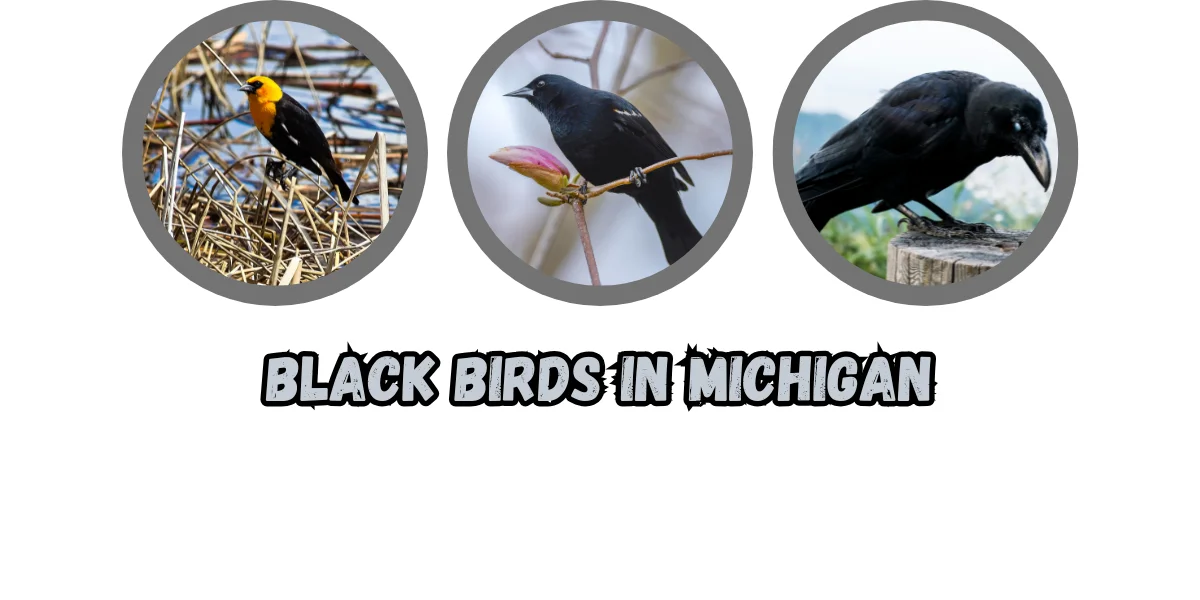
2 thoughts on “20 Types Of Black Birds in Michigan: List, details & Photos”